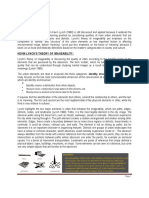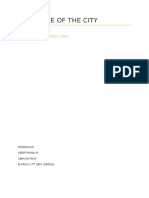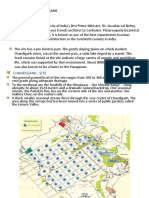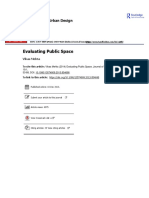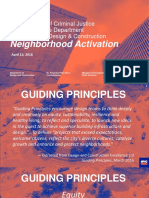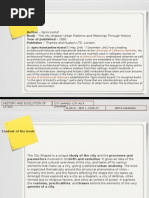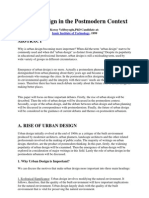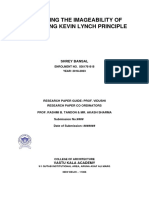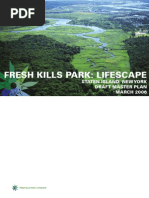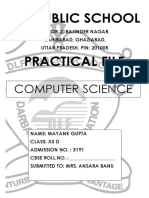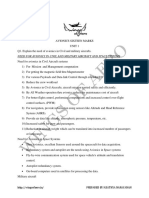Townscape - Gordon Cullen - Module 3
Townscape - Gordon Cullen - Module 3
Uploaded by
Nymisa RavuriCopyright:
Available Formats
Townscape - Gordon Cullen - Module 3
Townscape - Gordon Cullen - Module 3
Uploaded by
Nymisa RavuriOriginal Title
Copyright
Available Formats
Share this document
Did you find this document useful?
Is this content inappropriate?
Copyright:
Available Formats
Townscape - Gordon Cullen - Module 3
Townscape - Gordon Cullen - Module 3
Uploaded by
Nymisa RavuriCopyright:
Available Formats
Gordon Cullen (1914-1994) was an English architect, an urban designer who carried
on the Townscape movement theme. Later on he wrote and published the “Townscape”
book in 1961. He was a key motivator and activist in the development of British theories
of urban design in the post-war period. Townscape is made up from articles published in
post wars years in the architectural review. The author’s definition of townscape is that
one building is architecture but two buildings is townscape. The relationship between
buildings and the space between buildings assume importance. Apart from the scientific
research and solutions arrived through planning, we need to ‘manipulate within the
tolerances’ to make the city interesting and soulful. For this the author says, we must
turn to the faculty of sight, for it is almost entirely through vision that the environment is
apprehended. The environment produces an emotional reaction in three deferent ways.
1. Concerning OPTICS: The pedestrian walks through the town at a uniform speed.
The scenery is often revealed in a series of jerks and revelations. This is termed
as SERIAL VISION. The elements of the town are manipulated to achieve an
impact on emotions. The town comes alive through the drama of juxtaposition
which otherwise would slip past featureless and inert.
2. Concerning PLACE: It is concerned with ours reactions to the position of our
body in its environment. It deals with the experience stemming from major
impacts of exposure and enclosure. Utilize this sense of identity with the
environment, the feeling of a person in a street or square that he is in it or
entering it or leaving it. Eg. Rashtrapati Bhavan
3. Concerning CONTENT: It is an examination of the fabric of towns – Colour,
texture, scale, style, character, personality and uniqueness. Most town fabric will
show evidence of differing periods in its architectural styles. Towns do display a
mixture of styles, materials and scales.
Townscape identifies 3 gateways to translate an environment into a home for
human beings, that of motion, that of position and that of content. By the exercise
of vision, it became apparent that motion was not one simple, measurable
progression but it is two things, the existing and the revealed view. Also, human
being is constantly aware of his position in the environment, he feels the need for
a sense of place. Conformity killed and the agreement to differ gave life to cities.
Here and There
The practical result of so articulating the town into identifiable parts is that no sooner do
we create a HERE than we have to admit a THERE, and it is precisely in the
manipulation of these two spatial concepts that a large part of urban drama arises.
Man-made enclosure, if only of the simplest kind, divides the environment into HERE
and THERE. On this side of the arch, in Ludlow, we are in the present, uncomplicated
and direct world, our world. The other side is different, having in some small way a life
of its own (a with-holding).
You might also like
- Alteryx PPTDocument13 pagesAlteryx PPTZain IqbalNo ratings yet
- 5 E's APPROACHDocument31 pages5 E's APPROACHRainiel Victor M. Crisologo100% (6)
- Wexner Essay - SchellhammerDocument5 pagesWexner Essay - SchellhammerMuhammad Tahir PervaizNo ratings yet
- Urbanization and Peri-Urbanization: Aggressive Competition and Unresolved Conflicts - The Case of Chennai City in IndiaDocument26 pagesUrbanization and Peri-Urbanization: Aggressive Competition and Unresolved Conflicts - The Case of Chennai City in IndiaSudharsanamurthy PunniamurthyNo ratings yet
- Planning The Ideal CityDocument11 pagesPlanning The Ideal CityGianluca SpinatoNo ratings yet
- Human Aspects - Rapoport PDFDocument4 pagesHuman Aspects - Rapoport PDFRahmi Ranju OrangestNo ratings yet
- Book ReviewDocument3 pagesBook ReviewDevyani TotlaNo ratings yet
- Hms URBAN DESIGN - 3Document11 pagesHms URBAN DESIGN - 3dinesh royal100% (1)
- Unit 3 Refud - 3 RefDocument11 pagesUnit 3 Refud - 3 Refbharathkalai100% (1)
- Gordon CullenDocument4 pagesGordon CullenDevyani TotlaNo ratings yet
- Theorising and Reading Urban SpaceDocument16 pagesTheorising and Reading Urban SpaceRamya priyaNo ratings yet
- The Image of The CityDocument9 pagesThe Image of The CityKavya KrishnamurthyNo ratings yet
- Gordon CullenDocument6 pagesGordon CullenNammuBondNo ratings yet
- Cultural Continuum and Regional Identity in Architecture PDFDocument5 pagesCultural Continuum and Regional Identity in Architecture PDFValdriana CorreaNo ratings yet
- Functional & TemporalDocument21 pagesFunctional & TemporalAr. Shama ParweenNo ratings yet
- Contribution: Safety and Security in Public SpaceDocument6 pagesContribution: Safety and Security in Public Spacesomya guptaNo ratings yet
- 02 Fort Management Plan ReportDocument52 pages02 Fort Management Plan ReportNeeti CharlesNo ratings yet
- Interrogating POP in Architecture IntroductionDocument9 pagesInterrogating POP in Architecture IntroductionVivienne KangNo ratings yet
- Sustainable City Forms-JabareenDocument16 pagesSustainable City Forms-Jabareenbharajvikram9147No ratings yet
- Chandigarh City GridsDocument22 pagesChandigarh City GridsarchayuNo ratings yet
- The - New - New Brutalism by Michael JDocument6 pagesThe - New - New Brutalism by Michael JSomeonealreadygotthatusername.No ratings yet
- Place Making in The Digital AgeDocument18 pagesPlace Making in The Digital AgeSaffa RoshanNo ratings yet
- Christopher AlexanderDocument23 pagesChristopher Alexanderrifquth sb100% (1)
- HJK DissertationDocument51 pagesHJK DissertationShubham MathurNo ratings yet
- Gaurish Deshpande - Historical Evolution of PuneDocument15 pagesGaurish Deshpande - Historical Evolution of PuneGaurish DeshpandeNo ratings yet
- Mehta 2014 Evaluating Public Space - UnlockedDocument53 pagesMehta 2014 Evaluating Public Space - UnlockedAshariNo ratings yet
- Analysis of Urban Design Chapter: Delhi Master Plan (1962,2001,2021)Document16 pagesAnalysis of Urban Design Chapter: Delhi Master Plan (1962,2001,2021)Smriti SNo ratings yet
- City's Presentation On Crime Prevention Through DesignDocument39 pagesCity's Presentation On Crime Prevention Through DesignDNAinfoNewYorkNo ratings yet
- City As A DiagramDocument34 pagesCity As A DiagramsmitahiraparaNo ratings yet
- Working Paper - Tracing Modern Heritage in Panjim Landmarks - ChinmaySomanDocument14 pagesWorking Paper - Tracing Modern Heritage in Panjim Landmarks - ChinmaySomanChinmay SomanNo ratings yet
- MaduraiDocument8 pagesMaduraiRam GopalNo ratings yet
- Perception of An Urban Public Place: A Case Study of Martyrs' Square, TrivandrumDocument8 pagesPerception of An Urban Public Place: A Case Study of Martyrs' Square, TrivandrumAnjana Mary Jacob0% (1)
- Course File - UD - Lesson Plan - AR6911Document8 pagesCourse File - UD - Lesson Plan - AR6911Jayaraman NNo ratings yet
- Urban Design in Postmodern ContextDocument14 pagesUrban Design in Postmodern ContextNsna Archibanism100% (2)
- Urbanization in IndiaDocument5 pagesUrbanization in IndiageetNo ratings yet
- Research PaperDocument5 pagesResearch PaperShreya BansalNo ratings yet
- Lakes of Coimbatore City PDFDocument50 pagesLakes of Coimbatore City PDFNavin PrabaharanNo ratings yet
- The Image of The CityDocument8 pagesThe Image of The CitykuldeepNo ratings yet
- Evolution of Public Space From Ancient To Modern EraDocument7 pagesEvolution of Public Space From Ancient To Modern EraSHEFALI KULKARNINo ratings yet
- JNNURM Heritage ToolkitDocument16 pagesJNNURM Heritage ToolkitSuchandra AddyaNo ratings yet
- Urban Village TheoryDocument17 pagesUrban Village TheoryNadhirah Agasshi0% (1)
- Urban PlanningDocument17 pagesUrban PlanningFrianne FrondarinaNo ratings yet
- The City Image and Its Elements by KevinDocument3 pagesThe City Image and Its Elements by Kevinwowielauria100% (1)
- Tokyo UrbanizationDocument24 pagesTokyo Urbanization1210101075 SAUMYAJIT BISWASNo ratings yet
- Urban Morphology-Yenikapı İstanbul, Morphological Research On Yenikapı.Document38 pagesUrban Morphology-Yenikapı İstanbul, Morphological Research On Yenikapı.ferdiNo ratings yet
- JON LANG International Urban Designs - Brands in Theory and PracticeDocument9 pagesJON LANG International Urban Designs - Brands in Theory and PracticeRohayah Che AmatNo ratings yet
- Edinburgh PDFDocument18 pagesEdinburgh PDFPaula PrietoNo ratings yet
- Module 2, Urban DesignDocument40 pagesModule 2, Urban DesignPraveen Shetty100% (1)
- Musi River Brige DesginDocument10 pagesMusi River Brige DesginM S KumarNo ratings yet
- City As A Visual ExperienceDocument26 pagesCity As A Visual ExperienceAr. Shama ParweenNo ratings yet
- Fresh Kills Park LifescapeDocument66 pagesFresh Kills Park Lifescapenyc100% (6)
- Unit 1 - Santélia - Le Corb - Mies PDFDocument32 pagesUnit 1 - Santélia - Le Corb - Mies PDFNandha Palani DoraiNo ratings yet
- Multi Functionality of Public SpaceDocument7 pagesMulti Functionality of Public Spacemahmuda mimiNo ratings yet
- Class 04 Ud Concepts Gordon CullenDocument47 pagesClass 04 Ud Concepts Gordon CullenShreyaNo ratings yet
- UD AMS - Harini - UNIT 1Document83 pagesUD AMS - Harini - UNIT 1Divya PurushothamanNo ratings yet
- Vertical UrbanismDocument6 pagesVertical Urbanismnubis_zionNo ratings yet
- Urban Design Project 2 Portfolio-A3 PortfolyoDocument21 pagesUrban Design Project 2 Portfolio-A3 PortfolyoferdiNo ratings yet
- Urban Space Seminar-Bhopal EditDocument7 pagesUrban Space Seminar-Bhopal EditDavid DanielsNo ratings yet
- Decoding Third PlacesDocument91 pagesDecoding Third PlacesAkankshaNo ratings yet
- Authorship and Modernity in Chandigarh: The Ghandi Bhavan and The Kiran Cinema Designed by Pierre Jeanneret and Edwin Maxwell FryDocument29 pagesAuthorship and Modernity in Chandigarh: The Ghandi Bhavan and The Kiran Cinema Designed by Pierre Jeanneret and Edwin Maxwell FryErik R GonzalezNo ratings yet
- The Rite of Urban Passage: The Spatial Ritualization of Iranian Urban TransformationFrom EverandThe Rite of Urban Passage: The Spatial Ritualization of Iranian Urban TransformationNo ratings yet
- New Urbanism-Peter Calthorpe - Module 3Document2 pagesNew Urbanism-Peter Calthorpe - Module 3Nymisa RavuriNo ratings yet
- Annex I - Bill of Quantities - BOQDocument62 pagesAnnex I - Bill of Quantities - BOQNymisa RavuriNo ratings yet
- Unit 2 Forms of Human SettlementDocument20 pagesUnit 2 Forms of Human SettlementNymisa RavuriNo ratings yet
- Valuation BarchDocument29 pagesValuation BarchNymisa RavuriNo ratings yet
- Growth and Decay of Human SettlementsDocument2 pagesGrowth and Decay of Human SettlementsNymisa Ravuri0% (2)
- Leed ScoreDocument1 pageLeed ScoreNymisa RavuriNo ratings yet
- Tesla Manufacturing UnitDocument1 pageTesla Manufacturing UnitNymisa RavuriNo ratings yet
- Estimating, Budgeting and Cost ControlDocument18 pagesEstimating, Budgeting and Cost ControlNymisa RavuriNo ratings yet
- Human Settlements and PlanningDocument128 pagesHuman Settlements and PlanningNymisa RavuriNo ratings yet
- Critical Path MethodDocument13 pagesCritical Path MethodNymisa RavuriNo ratings yet
- Egypt Geography Lesson PlanDocument3 pagesEgypt Geography Lesson PlanWilliam BaileyNo ratings yet
- Fatigue FailureDocument46 pagesFatigue FailureAhmad SalahNo ratings yet
- CDT05104-Basics of Community Development233Document31 pagesCDT05104-Basics of Community Development233pterpaul320No ratings yet
- Timoshenko Beam Theory Exact Solution For Bending, Second-Order Analysis, and StabilityDocument22 pagesTimoshenko Beam Theory Exact Solution For Bending, Second-Order Analysis, and StabilityTrươngVănMếnNo ratings yet
- Using A Rotary Encoder On The MicrobitDocument2 pagesUsing A Rotary Encoder On The MicrobitTed SunNo ratings yet
- PDFDocument27 pagesPDFMarcos Antônio MartinsNo ratings yet
- School Form 2 (SF2) Daily Attendance Report of Learners: 109538 2022 - 2023 March Dolores Elementary School Kinder GoldDocument2 pagesSchool Form 2 (SF2) Daily Attendance Report of Learners: 109538 2022 - 2023 March Dolores Elementary School Kinder Goldsherwin gernaleNo ratings yet
- Chilean Operation Reviews: by Felipe Lazcano VicencioDocument9 pagesChilean Operation Reviews: by Felipe Lazcano VicencioIsidora Lazcano BarrosNo ratings yet
- Traders WorldDocument60 pagesTraders WorldSushant KanadeNo ratings yet
- 05 - Chapter 2Document44 pages05 - Chapter 2Nalabolu Eshwari EshwariNo ratings yet
- Inggris 301Document5 pagesInggris 301hakimzainulNo ratings yet
- Presentation On Workforce Diversity FinalDocument14 pagesPresentation On Workforce Diversity Finaldivyaprk9No ratings yet
- CollantDocument2 pagesCollantpogee752No ratings yet
- CS PracDocument54 pagesCS PracKanish ChughNo ratings yet
- PMK-2 - Nguyen Tan Anh - Reflective JournalDocument10 pagesPMK-2 - Nguyen Tan Anh - Reflective JournalTan Anh NguyenNo ratings yet
- Harold Aspden - The Physics of CreationDocument276 pagesHarold Aspden - The Physics of Creationtrashbox1368100% (3)
- 24 Poems About School, Short PoemsDocument1 page24 Poems About School, Short Poemstarita.alexandrinaNo ratings yet
- AVIONICS 16 Marks With AnsDocument32 pagesAVIONICS 16 Marks With Anssabari sabariNo ratings yet
- Astm D6773-08Document28 pagesAstm D6773-08Black GokuNo ratings yet
- Weekly Test Class 10Document4 pagesWeekly Test Class 10sweetyNo ratings yet
- Caie As Level Geography 9696 Core Physical Geography v2Document18 pagesCaie As Level Geography 9696 Core Physical Geography v2kgethilwemakgotsoNo ratings yet
- Roundel 1958-05 Vol 10 No 4Document36 pagesRoundel 1958-05 Vol 10 No 4TateNo ratings yet
- Mathematics - I (MATH F111)Document70 pagesMathematics - I (MATH F111)Ansh MohtaNo ratings yet
- Criticalbookreview Teaching MediaDocument4 pagesCriticalbookreview Teaching MediaHotrina SiregarNo ratings yet
- Lesson 02. Handouts - Answer KeyDocument5 pagesLesson 02. Handouts - Answer KeyYassine BouzekriNo ratings yet
- 4 Android Toast and Dialog PDFDocument16 pages4 Android Toast and Dialog PDFMark D. FelicianoNo ratings yet
- TESTDocument6 pagesTESTHuyenPhamNo ratings yet
- Integrate Reading Writing Basic 4 Students BookDocument114 pagesIntegrate Reading Writing Basic 4 Students BookWong CheungNo ratings yet








